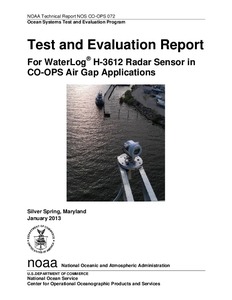| dc.contributor.author | Heitsenrether, R. | |
| dc.contributor.author | Hensley, W. | |
| dc.date.accessioned | 2018-12-12T18:48:42Z | |
| dc.date.available | 2018-12-12T18:48:42Z | |
| dc.date.issued | 2013 | |
| dc.identifier.citation | Heitsenrether, R. and Hensley, W. (2013) Test and Evaluation Report for WaterLog® H-3612 Radar Sensor in CO-OPS Air Gap Applications. Silver Spring, MD, NOAA NOS Center for Operational Oceanographic Products and Services, 43pp & appendices. (NOAA Technical Report NOS CO-OPS 072). DOI: http://dx.doi.org/10.25607/OBP-137 | en_US |
| dc.identifier.uri | http://hdl.handle.net/11329/572 | |
| dc.identifier.uri | http://dx.doi.org/10.25607/OBP-137 | |
| dc.description.abstract | In 2005, the National Oceanic and Atmospheric Administration (NOAA) National Ocean Service
(NOS) Center for Operational Oceanographic Products and Services (CO-OPS) completed the
development, testing, and transition to operations of an air gap-bridge clearance measurement
system for use in the CO-OPS Physical Oceanographic Real-Time System (PORTS®). The
purpose of this measurement system is to provide real-time observations of the vertical distance
from a bridge’s lowest steel to the mean water level surface below, commonly referred to as air
gap. The observation provides vessel pilots with decision support information that can decrease
the likelihood of vessel overhead allisions with bridges. This development and test effort was
motivated and supported by several PORTS® customers who were concerned with growing
bridge allision risks resulting from significant increase in vessel size and vessel traffic across
several U.S. ports and harbors.
Developed and transitioned to operations in 2005 by CO-OPS Ocean System Test and
Evaluation Program (OSTEP), the air gap system employs a microwave band radar range sensor
to measure the distance from a point on a bridge to the water surface below. The radar sensor
selected for that system is a Miros model SM-094. Initial development efforts and several
related reports and presentations clearly conveyed that microwave radar technology is the best
choice for the PORTS® air gap measurement applications.
OSTEP has continued test and development efforts with radar range sensors for other CO-OPS
applications, partly because of the success of the PORTS® air gap system. From 2008-2011,
OSTEP expended significant effort to test and evaluate four different brands of radar range
sensors to assess their suitability for use as primary water level sensors throughout the CO-OPS
National Water Level Observation Network (NWLON). Three years of additional field and lab
testing has resulted in a significant increase in CO-OPS’ knowledge of microwave radar sensor
technology, both through analysis of test data and hands-on field experience with sensors.
Additional information about other available commercial-off-the-shelf sensor brands and models
was also obtained through the effort. This wealth of knowledge gained through additional radar
sensor testing for NWLON applications has been leveraged to support a number of
improvements to existing operational air gap measurement systems. Recent improvements
include enhanced laboratory test procedures and analysis tools, Sutron Xpert data collection
platform software upgrades, and new mounting hardware designs.
Most recently, the OSTEP team has identified the Design Analysis WaterLog® H-3612
microwave radar as a potential alternative PORTS® air gap sensor, based on test results for
NWLON applications. This sensor, already used in some CO-OPS water level applications,
offers many advantages over CO-OPS’ current operational sensor, the Miros SM-094.
Motivated by the potential to improve existing PORTS® air gap systems, OSTEP conducted a
series of laboratory and field tests on the WaterLog® H-3612 designed to assess the suitability
for use in PORTS® air gap applications. All laboratory tests conducted indicate that the
WaterLog® H-3612 meets CO-OPS operational standards. Field testing included the installation
of a test WaterLog® sensor alongside an operational Miros SM-094 sensor at the PORTS® station
on the Reedy Point, DE Bridge for eight months. WaterLog® and Miros sensors showed good
agreement during the field test for air gap data collected and transmitted every 6 minutes. The
monthly root mean squared deviation was less than 4 cm, and the monthly mean differences were
all less than 6.2 cm; both values are well below the real-time air gap measurement accuracy
requirement of ±15 cm, which CO-OPS established with prospective users during initial air gap
system development efforts [1]. Based on laboratory and field test results included in this report,
OSTEP has recommended use of the WaterLog® H-3612 radar sensor at CO-OPS operational air
gap stations where the sensor’s maximum 70-m range is not expected to be exceeded. | en_US |
| dc.language.iso | en | en_US |
| dc.publisher | NOAA, NOS Center for Operational Oceanographic Products and Services | en_US |
| dc.relation.ispartofseries | NOAA Technical Report NOS CO-OPS;072 | |
| dc.rights | CC0 1.0 Universal | * |
| dc.rights.uri | http://creativecommons.org/publicdomain/zero/1.0/ | * |
| dc.title | Test and Evaluation Report for WaterLog® H-3612 Radar Sensor in CO-OPS Air Gap Applications. | en_US |
| dc.type | Report | en_US |
| dc.description.status | Published | en_US |
| dc.format.pages | 43pp. & appendices | en_US |
| dc.description.refereed | Refereed | en_US |
| dc.publisher.place | Silver Spring, MD | en_US |
| dc.subject.parameterDiscipline | Parameter Discipline::Physical oceanography | en_US |
| dc.subject.instrumentType | Instrument Type Vocabulary::water level markers | en_US |
| dc.rights.license | Public Domain | |
| dc.description.currentstatus | Current | en_US |
| dc.description.eov | Sea surface height | en_US |
| dc.description.bptype | Best Practice | en_US |
| dc.description.bptype | Guide | en_US |
| obps.contact.contactemail | coops.webmaster@noaa.gov | |
| obps.resourceurl.publisher | https://tidesandcurrents.noaa.gov/pub.html | en_US |
 Repository of community practices in Ocean Research, Applications and Data/Information Management
Repository of community practices in Ocean Research, Applications and Data/Information Management

